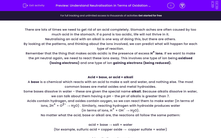There are lots of times we need to get rid of an acid completely. Stomach aches are often caused by too much acid in the stomach. If a pond is too acidic, life will not thrive in it.
Neutralising an acid with an alkali is one way of doing this, but there are others.
By looking at the patterns, and thinking about the ions involved, we can predict what will happen for each type of reaction.
Remember that the thing that makes acids acidic is the presence of excess H+ ions. If we want to make the pH neutral again, we need to react these ions away. This involves one type of ion being oxidised (losing electrons) and one type of ion gaining electrons (being reduced).
Acid + base, or acid + alkali
A base is a chemical which reacts with an acid to make a salt and water, and nothing else. The most common bases are metal oxides and metal hydroxides.
Some bases dissolve in water - these are given the special name alkali. Because alkalis dissolve in water, we can talk about them having a pH - the pH of alkalis is greater than 7.
Acids contain hydrogen, and oxides contain oxygen, so we can react them to make water (in terms of ions, 2H+ + O2- → H2O) . Similarly, reacting hydrogen with hydroxide produces water
(in terms of ions, H+ + OH- → H2O).
No matter what the acid, base or alkali are, the reactions all follow the same pattern:
acid + base → salt + water
(for example, sulfuric acid + copper oxide → copper sulfate + water)
acid + alkali → salt + water
(for example, nitric acid + sodium hydroxide → sodium nitrate + water)
Acid + metal
We can also react an acid with a metal. The products are a salt + hydrogen gas. The part of the acid which isn't hydrogen reacts with the metal to make a salt, leaving the hydrogen by itself.
The ionic equation for the hydrogen is 2H+ → H2. The hydrogen is reduced (it's gained electrons), and the metal is oxidised (it loses electrons).
acid + metal → salt + hydrogen
(for example, hydrochloric acid + magnesium → magnesium chloride + hydrogen)
Thinking about these reactions in terms of oxidation and reduction links them to the reactivity series. A metal will only react with acid if it is more reactive than hydrogen.
Acid + carbonate
The final reaction you need to know is what happens when we react acid with a carbonate compound. Carbonate is CO3, and hydrogen from the acid reacts with one of the oxygens to make water. That leaves CO2 left over, which is carbon dioxide.
acid + carbonate → salt + water + carbon dioxide
(for example, nitric acid + calcium carbonate → calcium nitrate + water + carbon dioxide)
The ionic equation for this type of reaction is 2H+ + CO32- → H2O + CO2.
Naming the salt
All these reactions produce a salt. The rules for naming the salt are the same for all the reactions:
1. Look at the name of the non-acid (the alkali / base / carbonate / metal). There will be a metal mentioned in the name, usually as the first word. Look at the examples in this Introduction - copper oxide, sodium hydroxide, magnesium, calcium carbonate. That metal name will be the metal in the name of the salt - look at the salts made in the examples - copper sulfate, sodium nitrate, magnesium chloride, calcium nitrate.
2. Now look at the acid used, which will tell you what type of salt is produced. There are three you are expected to know:
nitric acid, which produces nitrates
sulfuric acid, which produces sulfates
hydrochloric acid, which produces chlorides
Check the examples again - they all follow this rule.
And that's it! The name of the acid, and the metal added allow us to predict the salt form. The compound the metal is in initially (alkali, base, pure metal, carbonate) tells us what else is produced.
Now let's move on to some questions.







